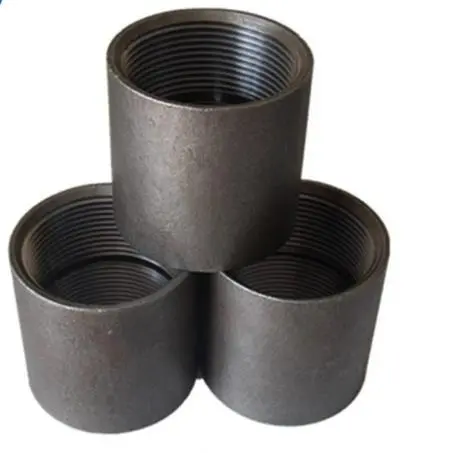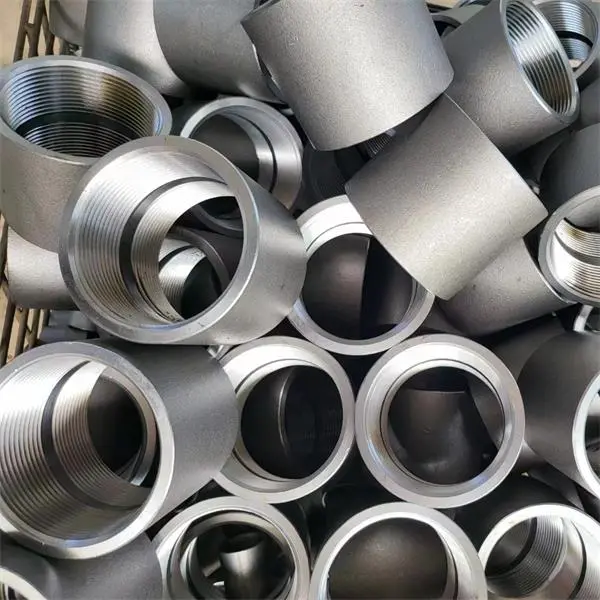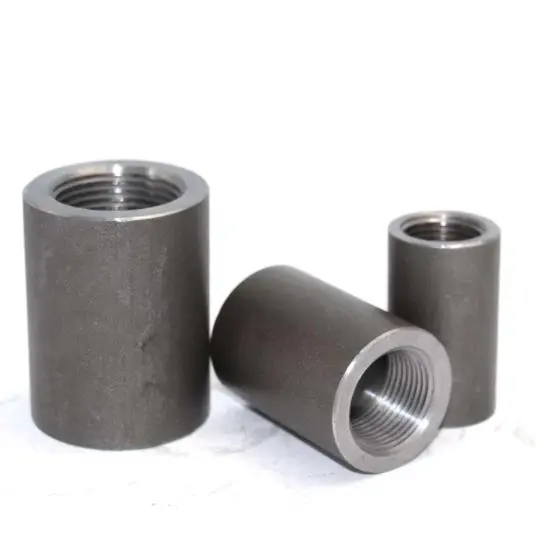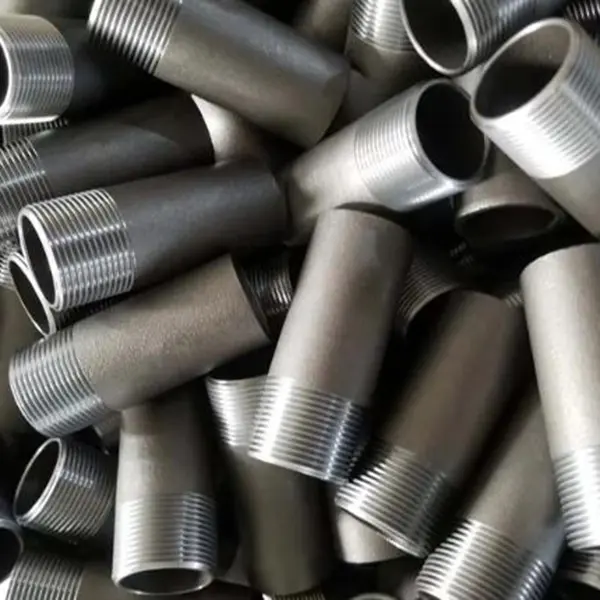Seamless A105 Carbon Steel Couplings for Robust Connections
Elevating Industrial Connectivity: The Imperative of Seamless Coupling Solutions
In the intricate landscape of modern industrial infrastructure, the integrity and reliability of piping systems are paramount. At the heart of this reliability often lies the critical component known as the seamless coupling. Unlike welded or threaded alternatives, a seamless design eliminates potential weak points, ensuring superior strength, remarkable leak resistance, and an extended operational lifespan, making it an indispensable choice for high-pressure, high-temperature, and corrosive environments. The demand for such robust connections is surging across diverse sectors, including oil and gas, petrochemicals, power generation, and water treatment, driven by increasingly stringent safety regulations, the necessity for zero-leak systems, and the pursuit of operational efficiency. As industries push the boundaries of extreme conditions and seek to minimize downtime, the adoption of advanced materials like coupling carbon steel and specific grades such as A105 coupling has become a standard. This evolution reflects a broader industry trend towards engineered solutions that offer not just connection, but unparalleled performance stability and long-term cost-effectiveness. Our focus here delves deep into the technological advantages, critical applications, and the meticulous engineering behind these essential components, providing B2B decision-makers and technical professionals with the comprehensive insights required to make informed procurement and design choices that ensure system integrity and operational excellence in the face of evolving industrial demands.
The Precision Craftsmanship: Unveiling the Manufacturing Process of Seamless Couplings
The production of a high-quality seamless coupling is a testament to precision engineering, involving a multi-stage process that guarantees its structural integrity and performance. It typically commences with the selection of premium-grade raw materials, often high-strength coupling carbon steel, such as ASTM A105 for general service or specialized alloys like A350 LF2 for low-temperature applications, ensuring the material properties meet the stringent requirements of various industrial standards. The initial material, usually in bar form, undergoes a critical hot forging process, where it is heated to a precise temperature and then shaped under immense pressure. This forging aligns the grain structure, enhancing the mechanical properties, including tensile strength, yield strength, and impact resistance, far beyond what could be achieved with casting. Following forging, the components are subjected to a meticulous heat treatment regimen, which can include normalizing, quenching, and tempering, to refine the grain structure, relieve internal stresses, and achieve the desired hardness and toughness. Subsequently, advanced CNC (Computer Numerical Control) machining takes center stage. This phase is crucial for achieving the precise dimensions, smooth bore, and accurate thread profiles (if applicable, for threaded seamless couplings) that ensure a perfect fit and leak-free connection. The precision of CNC machining minimizes material waste and guarantees adherence to tight tolerances specified by international standards like ANSI (American National Standards Institute) and ISO (International Organization for Standardization). Throughout every stage, rigorous quality control and inspection protocols are implemented, including non-destructive testing (NDT) methods like ultrasonic testing, magnetic particle inspection, and visual inspection, to detect any flaws and ensure compliance with ISO 9001 quality management systems. This comprehensive manufacturing approach ensures that each seamless coupling offers an exceptional service life, often exceeding 20 years under optimal conditions, contributing significantly to system reliability and safety in demanding sectors such as petrochemicals, metallurgy, and municipal water supply and drainage systems, where their corrosion resistance and energy efficiency from reduced pressure drops are invaluable assets.

Technical Specifications and Performance Metrics of Seamless Couplings
The selection of an appropriate seamless coupling hinges on a meticulous understanding of its technical parameters, which dictate its suitability for specific operational demands. Key specifications include nominal pipe size (NPS), typically ranging from 1/8 inch to 4 inches, though larger sizes can be custom-manufactured. Wall thickness (WT) is critical for pressure ratings, often conforming to schedules like SCH 40, SCH 80, SCH 160, or XXS, dictating the coupling's ability to withstand internal pressures. Pressure ratings themselves are standardized under classes such as Class 150, 300, 600, 900, 1500, and 2500, or PN10 through PN400 in metric systems, reflecting the maximum allowable working pressure. The material grade is fundamental, with common options including ASTM A105 for forged carbon steel coupling applications up to 450°C, A350 LF2 for low-temperature service down to -45°C, and stainless steel grades like ASTM A182 F304/304L or F316/316L for corrosive environments requiring enhanced resistance. End connections vary, encompassing threaded (NPT, BSPT), socket weld, and butt weld configurations, chosen based on system design and installation requirements. Temperature ranges are strictly defined for each material and pressure class, from cryogenic conditions to extremely high temperatures exceeding 500°C. Compliance with industry standards like ASME B16.11 (forged fittings), ASME B31.3 (process piping), and MSS SP-83 (carbon steel couplings) is essential, ensuring interoperability and safety across complex piping networks. Furthermore, surface finishes, such as black phosphate coating or galvanization, are often applied to enhance corrosion resistance, particularly for A105 coupling used in external or moderately corrosive settings. These precise technical characteristics enable engineers to specify couplings that precisely match the fluid dynamics, temperature extremes, and chemical compositions of their industrial processes, guaranteeing optimal performance and longevity.
| Parameter | Typical Range/Value | Applicable Standard | Notes/Considerations |
|---|---|---|---|
| Nominal Pipe Size (NPS) | 1/8" - 4" (DN6 - DN100), larger upon request | ASME B36.10M | Matches pipeline diameter for uniform flow. |
| Pressure Rating | Class 150, 300, 600, 900, 1500, 2500 (PN10-PN400) | ASME B16.11, MSS SP-83 | Determined by material, wall thickness, and temperature. |
| Material Grades | ASTM A105 (Carbon Steel), A350 LF2 (Low Temp Carbon Steel), A182 F304/F316 (Stainless Steel) | ASTM A105, A350, A182 | Selection depends on fluid corrosivity, temperature, and pressure. |
| End Connections | Threaded (NPT, BSPT), Socket Weld (SW), Butt Weld (BW) | ASME B1.20.1, ASME B16.11 | Dictates joining method with pipes. Threaded for easy assembly/disassembly. |
| Wall Thickness Schedule | SCH 40, SCH 80, SCH 160, XXS | ASME B36.10M | Impacts mechanical strength and pressure resistance. |
| Operating Temperature Range | -45°C to 538°C (depending on material/class) | ASME B31.3 | Crucial for preventing material degradation and ensuring seal integrity. |
| Corrosion Resistance | High (especially for SS grades); can be enhanced by coatings for CS. | N/A (Material property) | Vital for chemical processing, wastewater, and marine applications. |

Unmatched Advantages: Why Seamless Couplings Outperform
The inherent advantages of a seamless coupling are multifaceted and significantly contribute to the overall efficiency, safety, and longevity of industrial piping systems. Firstly, their fundamental design, devoid of welds or joints in the body, inherently eliminates potential weak points that are common in fabricated or cast fittings. This homogeneous structure translates directly into superior mechanical strength and improved resistance to fatigue and stress corrosion cracking, particularly under dynamic loads or thermal cycling. This makes them exceptionally reliable in high-pressure applications where integrity is non-negotiable, such as hydraulic systems or steam lines. Secondly, the smooth, uninterrupted bore of a seamless coupling minimizes internal flow turbulence, leading to reduced pressure drops and enhanced fluid dynamics. This seemingly minor detail can result in substantial energy savings over the operational lifespan of a large-scale piping network, contributing to lower pumping costs and improved system efficiency. For industries where precise flow control is critical, such as chemical dosing or delicate material transfer, this smooth internal surface also prevents material accumulation, reducing the risk of contamination and blockages. Furthermore, the manufacturing process, particularly the forging of coupling carbon steel or A105 coupling, produces a dense, non-porous material structure that is highly resistant to leakage. This leak-proof quality is vital in hazardous material handling, preventing environmental contamination, ensuring personnel safety, and avoiding costly product loss. Their robust construction also means minimal maintenance requirements, leading to reduced operational expenditure (OpEx) and significantly less downtime for repairs or replacements. Finally, the enhanced resistance to external corrosion, especially when made from suitable alloys or treated with protective coatings, extends their service life even in aggressive environments, offering a lower total cost of ownership (TCO) compared to less durable alternatives. These combined technical advantages position seamless couplings as the preferred solution for mission-critical applications where failure is not an option.
Diverse Applications: Seamless Couplings in Critical Industrial Sectors
The versatility and robust performance of seamless coupling solutions render them indispensable across a spectrum of critical industrial applications, addressing specific challenges within each sector. In the demanding realm of Oil & Gas, seamless couplings are pivotal for upstream (exploration and production), midstream (transportation via pipelines), and downstream (refining and petrochemical processing) operations. Here, they are deployed in high-pressure wellhead equipment, subsea pipelines, and refinery units where extreme pressures, corrosive hydrocarbons, and wide temperature fluctuations necessitate connections with absolute integrity and zero leakage. The use of A105 coupling is particularly common for process piping, offering reliability in volatile environments. For Power Generation, including thermal, nuclear, and combined cycle plants, seamless couplings are crucial in steam lines, condenser circuits, and cooling water systems, where they must withstand high temperatures, fluctuating pressures, and potential for water hammer, ensuring continuous operation and preventing catastrophic failures. The Chemical and Petrochemical Processing industry relies heavily on seamless couplings for transporting a wide array of aggressive chemicals, acids, and solvents. Their superior corrosion resistance, especially when specified in stainless steel grades or with specialized internal coatings, prevents material degradation and contamination, safeguarding product purity and worker safety. In Water Treatment and Desalination Plants, these couplings are employed in high-pressure reverse osmosis systems, raw water intake lines, and treated water distribution networks, where resistance to corrosion from brines and treated water, coupled with long-term reliability, is essential for sustainable operations. Furthermore, the Shipbuilding and Marine industry utilizes seamless couplings in propulsion systems, ballast lines, and hydraulic systems onboard vessels, where they face constant exposure to saltwater, vibrations, and dynamic stresses, requiring components that offer unwavering durability and resistance to marine environments. Each application underscores the adaptability and critical role of seamless coupling technology in maintaining operational continuity and safety across the global industrial landscape.

Tailored Solutions: Customization and Engineering for Unique Demands
Recognizing that off-the-shelf solutions may not always suffice for highly specialized industrial projects, reputable manufacturers of seamless coupling products offer extensive customization and solution engineering capabilities. This bespoke approach ensures that the couplings perfectly integrate with existing infrastructure and meet unique operational parameters, thereby optimizing performance and minimizing potential compatibility issues. Customization extends to various aspects, beginning with material selection; beyond standard coupling carbon steel (like A105) and stainless steel, exotic alloys such as Inconel, Monel, or Hastelloy can be utilized for applications involving extremely aggressive chemicals, ultra-high temperatures, or severe corrosive environments. Dimensions can be precisely engineered, including non-standard pipe sizes, specific wall thicknesses, and custom end preparations to facilitate connections with legacy systems or specialized equipment. Pressure ratings and temperature ranges can also be tailored to exceed standard specifications, pushing the boundaries of performance for critical service lines. Furthermore, specific surface treatments, such as internal coatings (e.g., PTFE lining for chemical resistance), external passivation, or specialized painting, can be applied to enhance longevity and functional properties for specific fluid types or external atmospheric conditions. Our engineering team collaborates closely with clients from the initial design phase, utilizing advanced simulation software and Finite Element Analysis (FEA) to model performance under specific loads and environmental factors. This comprehensive engineering support ensures that every custom seamless coupling solution is rigorously designed, tested, and certified to meet or exceed the most demanding project specifications, providing unparalleled reliability and peace of mind for complex industrial applications where standard components simply cannot deliver the required performance or safety margins.
A Legacy of Trust: Assured Quality, Delivery, and Support
Choosing a supplier for seamless coupling components goes beyond mere product specifications; it fundamentally involves placing trust in a manufacturer's commitment to quality, adherence to timelines, and provision of comprehensive post-sales support. Our company prides itself on a proven track record of delivering high-performance coupling carbon steel and A105 coupling solutions to a global clientele for over two decades. This enduring presence in the market is underpinned by our stringent adherence to international quality management systems, including ISO 9001:2015 certification, ensuring every product manufactured meets the highest standards of excellence and traceability. We uphold a rigorous testing regime that includes hydrostatic pressure tests, material compositional analysis, and dimensional verification for every batch, guaranteeing that each seamless coupling will perform as expected in the field. Our manufacturing facilities are equipped with state-of-the-art machinery and operated by highly skilled technicians, allowing for precise control over the entire production process from raw material forging to final inspection. Our authority in the industry is further solidified by our long-standing partnerships with leading engineering firms and original equipment manufacturers (OEMs), who consistently rely on our products for their critical projects.
We understand that timely delivery is as crucial as product quality in industrial procurement. Our streamlined logistics and robust supply chain management enable efficient processing and global shipping, with typical lead times clearly communicated at the time of order confirmation, often ranging from 2-4 weeks for standard products and 6-8 weeks for highly customized solutions, depending on complexity and material availability. For urgent requirements, expedited manufacturing and shipping options can be arranged. Furthermore, our commitment to client satisfaction is demonstrated through a comprehensive warranty program covering manufacturing defects and material integrity for a specified period, typically 12 to 24 months from the date of installation. Beyond the sale, our dedicated technical support team, comprising experienced engineers and product specialists, is readily available to provide expert guidance on product selection, installation best practices, and troubleshooting. We believe in building lasting relationships with our clients by offering not just superior products, but also unparalleled service and responsiveness throughout the product lifecycle, cementing our reputation as a reliable and trustworthy partner in the industrial sector.

Frequently Asked Questions (FAQ) about Seamless Couplings
To further enhance clarity and address common inquiries from B2B decision-makers and technical personnel, we've compiled a list of frequently asked questions regarding the critical specifications and applications of seamless coupling solutions. Understanding these aspects is crucial for ensuring optimal system design, operational longevity, and compliance with industry standards.
-
Q1: What is the primary advantage of a seamless coupling over a welded one?
A: The primary advantage lies in the absence of a weld seam in the body, which eliminates potential weak points susceptible to stress concentrations, fatigue failure, and corrosion along the weld line. This results in superior mechanical strength, enhanced leak integrity, and a longer service life, particularly in high-pressure, high-temperature, and corrosive environments. The homogeneous material structure of a forged seamless coupling, such as an A105 coupling, offers inherent reliability that welded alternatives cannot consistently match.
-
Q2: How do I select the correct material for a seamless coupling?
A: Material selection is contingent upon the operating fluid's chemical composition, temperature, and pressure. For general service and non-corrosive fluids at moderate temperatures, coupling carbon steel like ASTM A105 is often sufficient. For low-temperature applications, ASTM A350 LF2 is recommended. Highly corrosive fluids or extreme temperatures necessitate stainless steel grades (e.g., 304/304L, 316/316L) or specialized alloys (e.g., Duplex, Super Duplex, Inconel). Consult with material specialists or refer to industry standards like ASME B31.3 for guidance based on your specific process conditions.
-
Q3: What are the typical inspection and testing standards for seamless couplings?
A: Reputable manufacturers adhere to international standards such as ASME B16.11 for forged fittings, MSS SP-83 for couplings, and general quality management systems like ISO 9001. Testing typically includes dimensional checks, material certification (MTC), visual inspection, hydrostatic pressure testing to specified pressure ratings, and non-destructive testing (NDT) methods like ultrasonic testing (UT), magnetic particle inspection (MPI), or liquid penetrant testing (LPT) to ensure the absence of internal or surface defects. These measures ensure the reliability and safety of the seamless coupling.
-
Q4: Can seamless couplings be used for highly corrosive or abrasive applications?
A: Yes, seamless couplings are well-suited for such demanding applications, provided the correct material and any necessary surface treatments are specified. For corrosive environments, stainless steel or nickel alloys are chosen for their inherent resistance. For abrasive media, specialized hardened alloys or internal ceramic/polymer linings can be integrated into the seamless coupling design. The smooth, seamless interior minimizes areas where abrasive particles could accumulate and cause wear, contributing to a longer service life in these challenging conditions.
-
Q5: What is the typical lead time for custom seamless coupling orders?
A: Lead times for custom seamless coupling orders can vary based on the complexity of the design, the type of material required (especially exotic alloys), and current production schedules. While standard items might ship within 2-4 weeks, custom orders involving specialized forging, machining, or heat treatments typically range from 6 to 12 weeks. We recommend consulting directly with our sales and engineering teams for precise lead time estimates tailored to your specific project requirements, ensuring transparent communication throughout the procurement process for your seamless coupling needs.
References and Authoritative Sources
- American Society of Mechanical Engineers (ASME). ASME B16.11: Forged Fittings, Socket-Welding and Threaded. New York: ASME, latest edition.
- American Society for Testing and Materials (ASTM). ASTM A105/A105M: Standard Specification for Forgings, Carbon Steel, for Piping Components. West Conshohocken, PA: ASTM International, latest edition.
- International Organization for Standardization (ISO). ISO 9001: Quality Management Systems – Requirements. Geneva, Switzerland: ISO, latest edition.
- Manufacturers Standardization Society of the Valve and Fittings Industry (MSS). MSS SP-83: Class 3000, 6000, and 9000 Carbon Steel Pipe Unions, Socket-Welding and Threaded. Vienna, VA: MSS, latest edition.
- Mohan, S. N. Metallurgy of Pipeline Steels. London: Academic Press, 2013.
